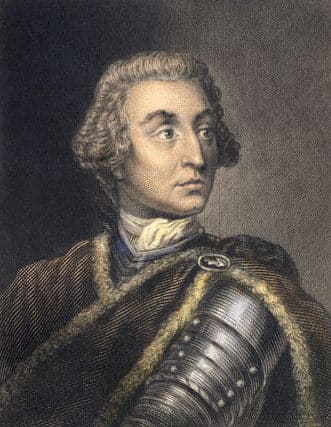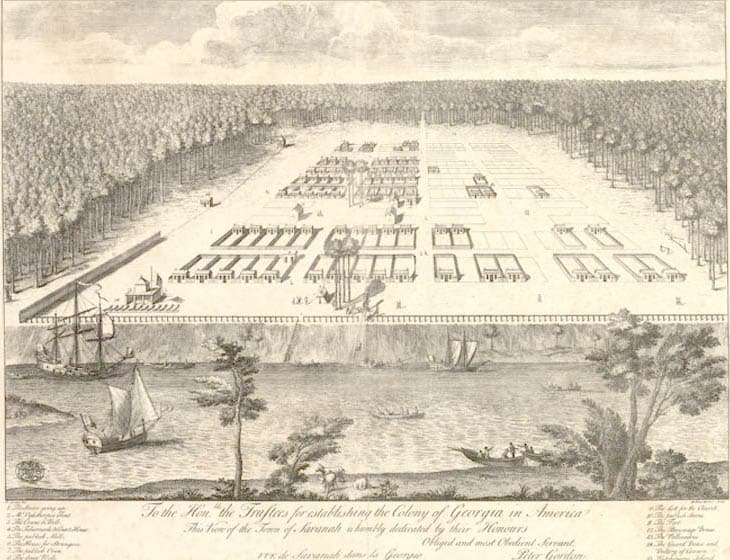The Georgia colony was founded by James Oglethorpe in 1732. It was the last colony established in the New World and would participate in the American Revolutionary War. Oglethorpe's original vision for Georgia was that of a haven for debtors or the "worthy poor."

It would also serve as a buffer against Indian attacks from Spanish Florida. The original charter prohibited slavery.
Jump to:
Georgia Colony Facts: Beginnings
The Privy Council approved the establishment charter on June 9, 1732, and for the next two decades, the council of trustees governed the province with the aid of annual subsidies from Parliament.
However, after many difficulties and the departure of Oglethorpe, the trustees proved unable to manage the proprietary colony, and on June 23, 1752, they submitted a deed of reconveyance to the crown, one year before the expiration of the charter.
On January 7, 1755, Georgia officially ceased to be a proprietary colony and became a crown colony.
From 1732 until 1758, the minor civil divisions were districts and towns. In 1758, without Indian permission, the Province of Georgia was divided into eight parishes by the Act of the Assembly of Georgia on March 15.
The Town and District of Savannah were named Christ Church Parish. The District of Abercorn and Goshen and the District of Ebenezer were named the Parish of St. Matthew. The District of Halifax was named the Parish of St. George.
The District of Augusta was named the Parish of St. Paul. The Town of Hardwick and the District of Ogeechee, including the islands of Ossabaw, were named the Parish of St. Philip.
From Sunbury in the District of Midway and Newport to the south branch of Newport, including the islands of St. Catherine and Bermuda, was named the Parish of St. John.
The Town and District of Darien, to the Altamaha River, including the islands of Sapelo and Eastwood, and including the sea islands north of Egg Island, was named the Parish of St. Andrew.
The Town and District of Frederica, including the islands of Great and Little St. Simons and the adjacent islands, was named the Parish of St. James.
Following Britain’s victory in the French and Indian War, King George III issued the Proclamation of 1763. One of its provisions was to extend Georgia’s southern boundary from the Altamaha River to the St. Marys River.
Two years later, on March 25, 1765, Gov. James Wright approved an act of the General Assembly creating four new parishes, St. David, St. Patrick, St. Thomas, and St. Mary in the newly acquired land, and further assigning Jekyll Island to St. James Parish. In 1777, the original eight counties of the State of Georgia were created.
In practice, settlement in the colony was limited to the near vicinity of the Savannah River. The western area of the colony remained under the control of the Creek Indian Confederation until after the American Revolutionary War.
In the beginning, the colony had a sluggish start. James Oglethorpe did not allow liquor, and colonists who came at the trustees' expense were not allowed to own more than 50 acres of land for their farm in addition to a 60-foot by 90-foot plot in town.
Those who paid their own way could bring ten indentured servants and would receive 500 acres of land. Additional land could neither be acquired nor sold.
Discontent grew in the colony because of these restrictions, and so Oglethorpe lifted them. With slavery, liquor, and land acquisition, the colony improved much faster.
Slavery had been permitted since 1749. There was some internal opposition, particularly from Scottish settlers, but by the time of the American Revolution, Georgia was much like the rest of the South.
On April 24, 1802, Georgia ceded to Congress parts of its western territories. These became the Mississippi Territory and later the states of Alabama and Mississippi.

Georgia Colony Facts: Revolutionary War in Georgia
When hostilities began to rise between Britain and the colonies, Georgia was reluctant to support the cause. Most of its citizens were not in favor of British trade regulations, but the tide began to swing in the other direction.
After the Battles of Lexington and Concord, support for independence grew substantially. The local leaders met on July 4, 1775, and agreed to send delegates to the Second Continental Congress (they were not present at the First Continental Congress).

In 1776, the British seized Rice Boats heading into the Savannah harbor. During this time, Colonel Lachlan McIntosh took charge of Georgia's defenses and began preparations for a British invasion.
In the early years of the war, Georgia did not experience many military conflicts but dealt with many internal problems.
Signer of the Declaration of Independence, Button Gwinnett, was suspected of being a loyalist, and he became the leader of a radical wing of Whigs.
He arrested George McIntosh, the brother of General Lachlan McIntosh. Button proceeded to usurp the General and began to plan an invasion of Florida.
This conflict came to a head when Lachlan McIntosh challenged Button Gwinnett to a duel.
A duel was still used to settle disputes in the 18th century. Gwinnett accepted the duel and took the field against McIntosh.
Both were shot, but Button Gwinnett died. After recovering from his wounds, McIntosh was then transferred from Georgia and served under General Washington during the winter at Valley Forge.
By 1778, the war in the North had reached a stalemate. The British high command decided to try a southern strategy. Southern governors like Sir James Wright had assured Lord George Germain, the American Secretary in Britain, that hundreds of loyalists bided their time in the backcountry, waiting for the king's troops.
General Sir Henry Clinton in New York ordered Lieutenant Colonel Archibald Campbell to invade Georgia with 3,000 troops and to restore the state to British rule, thus setting an example for the restoration of other former colonies. In the beginning, it seemed the strategy was working. However, delays from Native American allies and a nasty battle at Kettle Creek discouraged many British tories from joining the British cause.
Savannah did fall to British rule, and Georgia became the only colony to completely fall into British hands. British rule lasted until 1780, when Nathanael Greene and a handful of guerrilla leaders managed to drive the British out of the Georgia backcountry.
Savannah stayed in the hands of the British until 1782, when the British evacuated. Major General Anthony Wayne entered the city of Savannah and celebrated the American victory. Soon, Lyman Hall was elected as governor of Georgia.
